Overview
Plants draw down carbon dioxide (CO₂) from the atmosphere through photosynthesis. This process is an important part of the global carbon cycle, and results in carbon being sequestered in forests. For this reason, and because excess CO₂ in the atmosphere from burning fossil fuels is currently heating up the planet, forest conservation and reforestation are important parts of the suite of climate change solutions that people around the world are implementing.
Can we create a miniature, living model of plant photosynthesis on a tabletop, and demonstrate how plants draw down CO₂? This activity guides you through creating such a world in a tank.
Introduction
Students will design and test a closed system that will pull CO₂ levels down below pre-industrial atmospheric concentrations (that is, below 280 ppm). The objective is to design a tank where the rate of photosynthesis exceeds that of respiration so that CO₂ levels decrease on average over time.
Grade Level
6-8, 9-12, 13-14
Learning Objectives
Students will
- build a miniature ecosystem in a tank, using moss or other plants
- measure CO₂, temperature, and humidity in the air inside the tank
- consider solutions to move carbon from the atmosphere to the biosphere and/or the geosphere, and sequester it in these systems.
Lesson Format
In School: This is a lab activity. Students will work as a group.
Time Required
- Teacher setup before class: 30 minutes or less to test Air Quality Egg sensor
- Initial setup: 45-90 minutes (depends on the availability of supplies, e.g., aquatic plants)
- Data analysis: 15-45 minutes
- Experiment duration: 2-4 weeks
Standards
NGSS:
- Develop a model to illustrate the role of photosynthesis and cellular respiration in the cycling of carbon among the biosphere, atmosphere, hydrosphere, and geosphere. HS-LS2-5 Ecosystems: Interactions, Energy, and Dynamics
- Design, evaluate, and refine a solution for reducing the impacts of human activities on the environment and biodiversity. HS-LS2-7 Ecosystems: Interactions, Energy, and Dynamics
- Use a model to describe how variations in the flow of energy into and out of Earth’s systems result in changes in climate. HS-ESS2-4 Earth’s Systems
- Evaluate or refine a technological solution that reduces impacts of human activities on natural systems. HS-ESS3-4 Earth and Human Activity
- Apply scientific principles to design a method for monitoring and minimizing a human impact on the environment. MS ESS3-3 Earth and Human Activity
- Define the criteria and constraints of a design problem with sufficient precision to ensure a successful solution, taking into account relevant scientific principles and potential impacts on people and the natural environment that may limit possible solutions. MS-ETS1-1 Engineering Design
Credits & Contact Info
Toby Ault, Cornell University and Paleontological Research Institution
Frank Telles, Northern Arizona University
Danielle Eiseman, Cornell University
Rob Ross, Paleontological Research Institution
Ingrid Zabel, Paleontological Research Institution
Contact: Dr. Toby Ault, tra38@cornell.edu
Instructions & Materials
NOTE:
A limited number of kits with equipment may be available in the Central New York region. Please contact Dr. Toby Ault (tra38@cornell.edu) for information.
Equipment and Materials
- Aquarium (also referred to here as a tank). The photo below shows a setup using a standard, 10-gallon aquarium.
- One or two CO₂ monitors (e.g., Air Quality Egg, https://airqualityegg.com/. This instrument measures temperature and humidity as well as CO₂). One monitor is required; the second one is optional, to be used as a control to measure the air outside the tank.
- Plastic wrap or plexiglass lid
- Tape to seal the plastic wrap or lid
- Wireless hotspot (for locations without wifi); this is needed to get data from the CO₂ monitor.
- Glass jars or a bucket
- Portable grow light (not needed if the tank is placed near a window with sufficient sunlight). The bulb should be a full-spectrum bulb, of the type used for growing plants.
- Power strip with at least 4 outlets (for 2 Air Quality Eggs, grow light)
- Table (to place the aquarium, Air Quality Egg control, and anything else)
- About 1 gallon of fresh water from an outdoor source, such as a pond
- A few flat rocks that fit the bottom of the tank, to hold the CO₂ monitor and plants
- A small number of plants to put in the tank (see instructions below for some of the kinds of plants you might consider.)

Instructions
Your objective is to design a tank where the rate of photosynthesis exceeds that of respiration so that CO₂ levels decrease on average over time.
Setup (see also video below):
- Collect living organisms that can do photosynthesis (e.g., moss, grass, algae, ferns, flowers, sprouts, etc.)
- Pour some of the outdoor water you collected into the bottom of the tank.
- Place rocks in the water, and then assemble the plants in the tank, on the rocks. Add or remove water as needed so the plants are not submerged, but some water is wicking onto the rocks to hydrate the plants.
- Place a CO₂ monitor inside the tank and make sure that it is connected to the wifi. If you are using an Air Quality Egg, you should be able to see that data are being collected on the Air Quality Egg Portal (https://airqualityegg.com/portal/).
- NOTE: The Air Quality Egg—or other monitor that you may use—has an air intake and outtake. Make sure that these are unobstructed so air can flow in and out of the monitor. It is also helpful to have the monitor facing the edge of the tank, if possible, so you can read its display for troubleshooting.
- Seal the tank with the plexiglass lid or plastic wrap and tape. Make sure to seal carefully around the CO₂ monitor's power cord.
- Determine if your tank is properly sealed.
- There are various easy ways to do this and it is left up to you to decide what method you would like to use.
- The Air Quality Egg monitor will detect particulate matter such as smoke in the air, so if you create a source of smoke outside the tank and then check the particulate matter levels from inside the tank after the tank is sealed, you should be able to tell if the seal is good. Smoke particles would show up as particulate matter with diameter of 2.5 micrometers or smaller, or "pm2.5" in the Air Quality Egg's data, so if pm2.5 levels remain constant while the smoke is being generated, that is probably a sign that no environmental air is finding its way into the tank.
- Possible smoke sources:
- light a candle or match near the tank and then blow it out
- light some incense next to the tank
- light a rolled piece of paper and then blow it out immediately
- Position the tank in the sun. If you want to use a grow light to artificially turn light on and off, position this light facing the tank.
- If you are using a second Air Quality Egg as a control, set it up outside the tank, nearby.
Video of tank setup procedure
Run the experiment
- View the Air Quality Egg data (see instructions below) over time and observe if and how CO₂, temperature, and humidity fluctuate with the diurnal cycle (i.e., day and night.) How would you expect them to fluctuate with light and darkness?
- If you are using a grow light, you can control the length of your “days.”
- Make sure to take note of any other sources of light and sunlight that may influence your results.
- If CO₂ levels reach 10,000 ppm, the experiment is over. Open the tank up outside and clean it out with a weak bleach or hydrogen peroxide solution.
Tips
- You can change the duration of your experiment at any time or you can create as many new labs as you like. We have found that mosses and algae usually do an effective job, at least initially, at lowering CO₂ levels. However, plants and especially microbes will do lots of respiration.
- The more organic material that you add to your tank (e.g., dead leaves, topsoil, rotten wood), the harder it will be to keep CO₂ levels from climbing above 10,000 ppm.
Questions
- Why do CO2 levels, temperature, and humidity respond the way they do to light and darkness?
- How quickly do the plants in your tank respond to changes in light levels?
- Plants are made of about 45-50% carbon. As plants grow, from where are they getting this carbon?
- How could plants help to reduce the heating of our planet that is happening today?
- When plants die, what happens to the carbon that they took in from the atmosphere? What could we do to retain the carbon that plants have taken in from the atmosphere?
Connecting to the data portal and setting up an Air Quality Egg Lab
Watch this video and/or follow the written instructions below.
Instructions
- Navigate to the Air Quality Egg portal: https://airqualityegg.com/portal/.
- Log in (you’ll either have to register or use your gmail account).
- Once you are logged in, click on the three horizontal lines in the upper left corner next to “Educator Resources.”
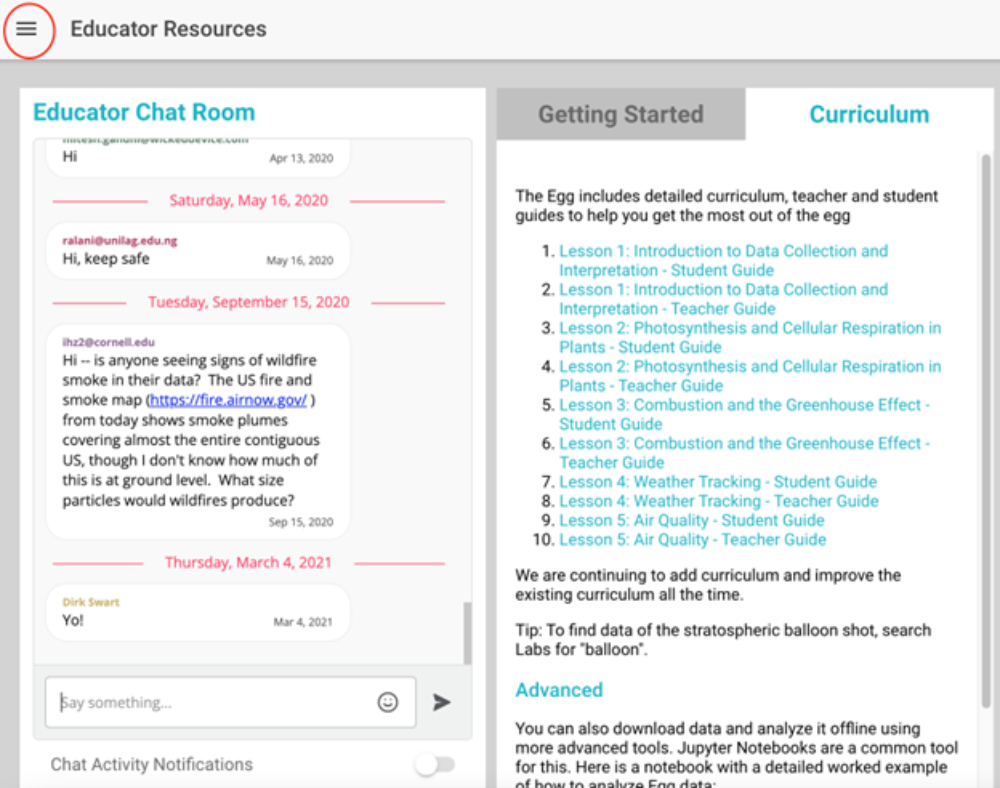
4. From the dropdown menu, select “Labs”

5. From the "Labs" page, select "My Data"

6. A big green circle with a plus sign should appear on the bottom right of this page. Click it.
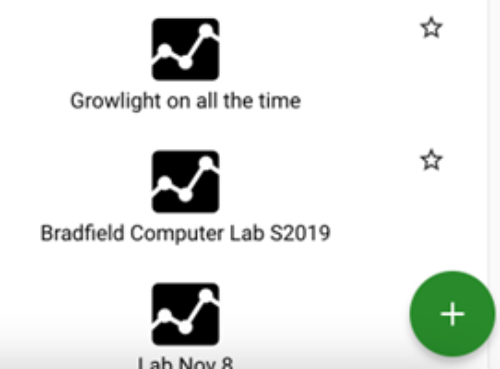
7. Again, select "Lab" (the icon that looks like a beaker.)
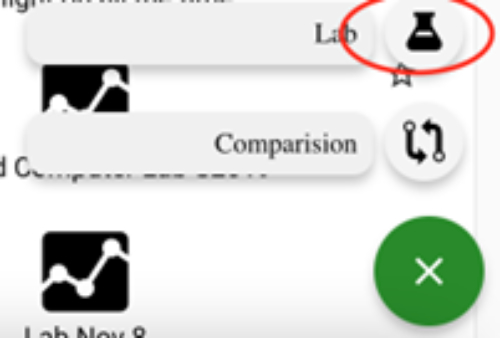
8. This will create a new (empty) experiment. To populate this experiment, you will need to find your “eggs” by clicking on the “Add Egg” button.

9. From there, search for your Egg(s). The name of the Egg should be written on its side along with a QR code and its serial number.
10. Once you have located the Egg(s) you would like to use for your experiment, set the start and end dates and times.
11. Refresh the data page and start doing science!
Background & Extensions
Photosynthesis and Respiration
Photosynthesis is the process by which a plant makes its food. The plant produces carbohydrates (sugars) using carbon dioxide (CO2) and water (H2O) molecules; as is well known, oxygen (O2) is also produced during photosynthesis. Sunlight provides the energy to make this happen. Leaves are often thin and flat to maximize their ability to intercept sunlight.
Photosynthesis transfers carbon dioxide from the atmosphere to plants, releasing oxygen in the process. Respiration runs this reaction backwards, releasing CO₂ while consuming oxygen.
C₆H₁₂O₆ + 6O₂ = 6CO₂ + 6H₂O
glucose + oxygen = carbon dioxide + water
Globally, photosynthesis removes 120 Pg (120 billion metric tons) of carbon every year from Earth’s atmosphere and turns it into the carbohydrates that make up living plants. Respiration and decay within ecosystems return that same amount of carbon to the atmosphere every year. We can quantitatively measure this flux in any outdoor environment, and compare it with anthropogenic carbon fluxes. Global climate change - especially rising temperature - can perturb the carbon cycle in both the short and long term.
Photosynthesis and respiration take place not only in land plants, but also in aquatic plants, including phytoplankton, which are the basis of the marine food web.
Related Activities
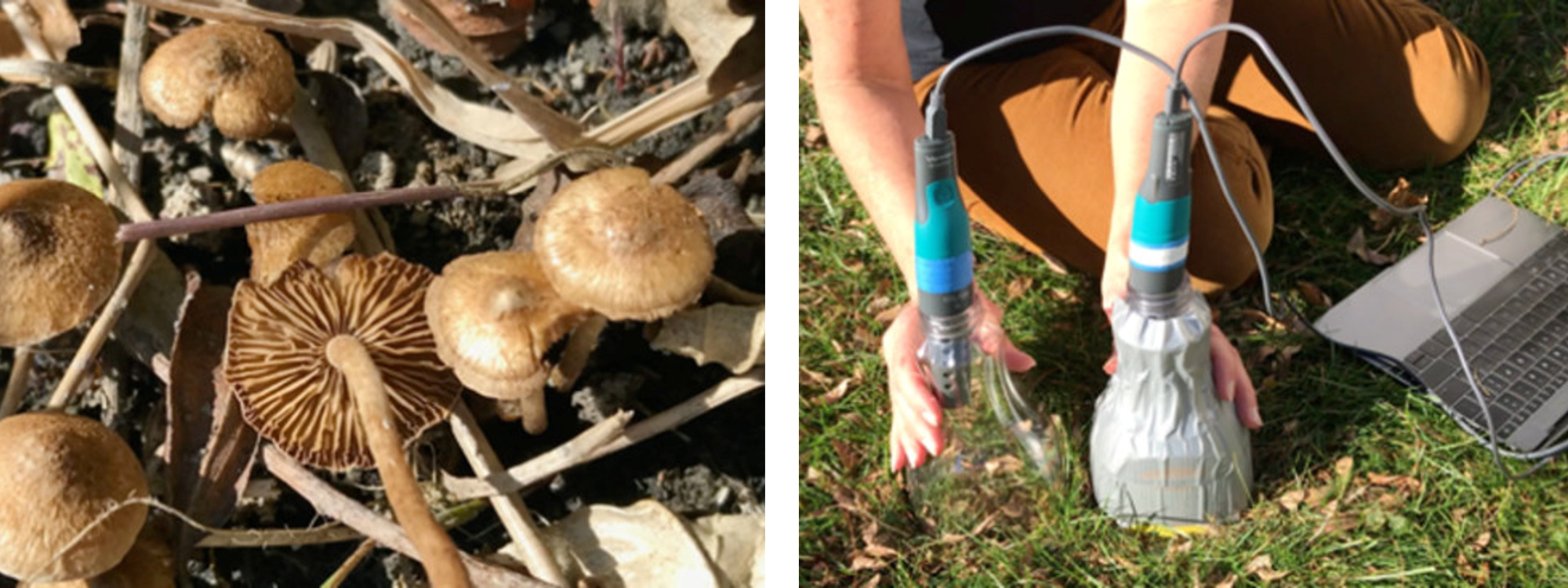
See the activity "Respiration" for an experiment students can do to measure the flux of carbon dioxide from soil to the atmosphere.
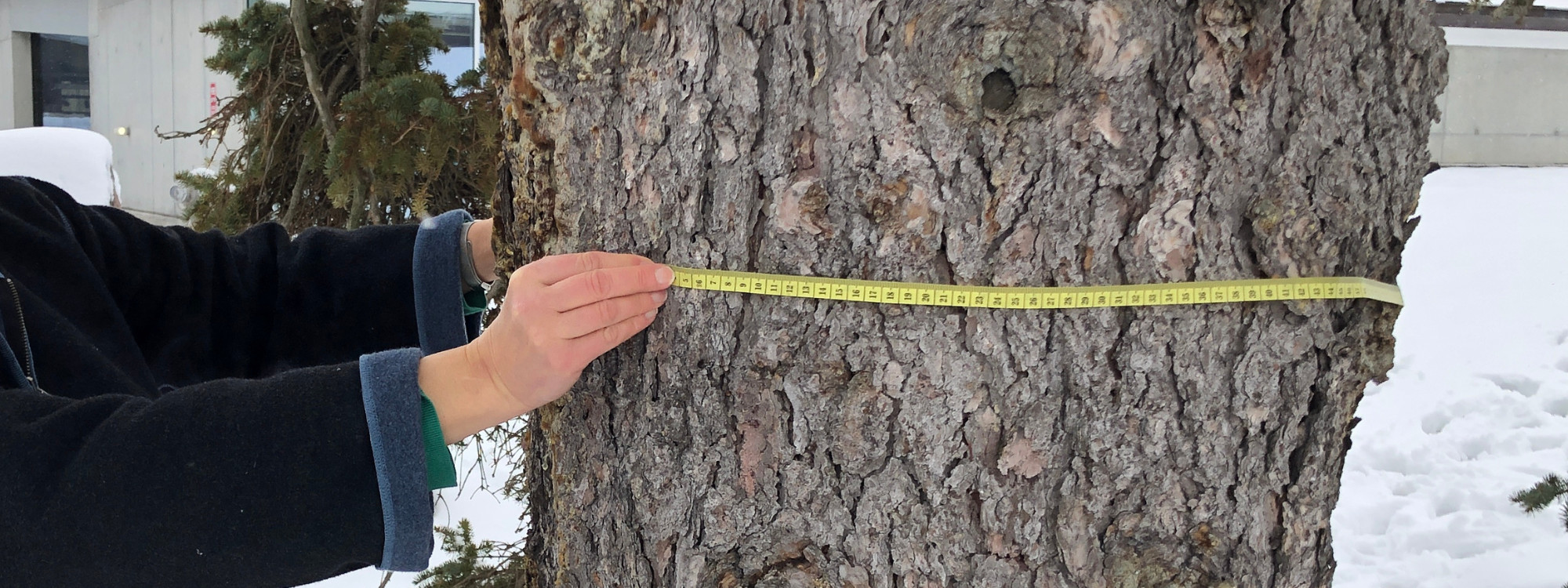
Related videos
CO₂ and Climate Change
To learn more about CO₂ and its role in regulating the Earth's surface temperature, see Greenhouse Gases and Global Temperature, a chapter section from The Teacher-Friendly Guide to Climate Change within the Digital Encyclopedia of Earth Science.
To learn more about forest-related actions as climate change solutions, see Climate Change Mitigation Strategies, a chapter section from The Teacher-Friendly Guide to Climate Change within the Digital Encyclopedia of Earth Science.
Project Drawdown has analyzed different actions people can take to reduce the levels of carbon dioxide in the atmosphere. Many of these actions involve plants.
- Tropical forest restoration
- Silvopasture
- Tree plantations on degraded land
- Temperature forest restoration
- Tree intercropping
- Multistrata agroforestry
- Conservation agriculture
- Abandoned farmland restoration
- Bamboo production
- Forest protection
- Perennial biomass production
- Grassland protection
- Seaweed farming
- Macroalgae protection and restoration
- Biochar production
- Coastal wetland restoration
- Green and cool roofs




